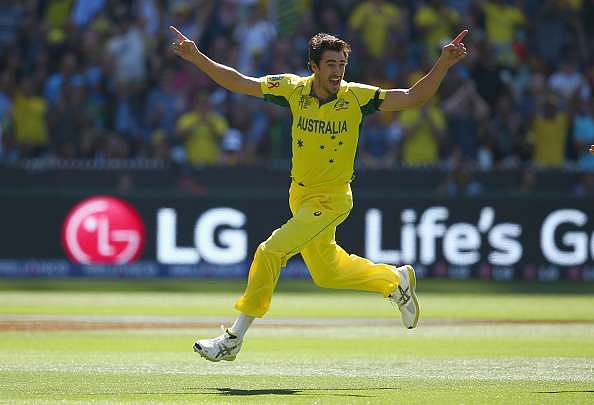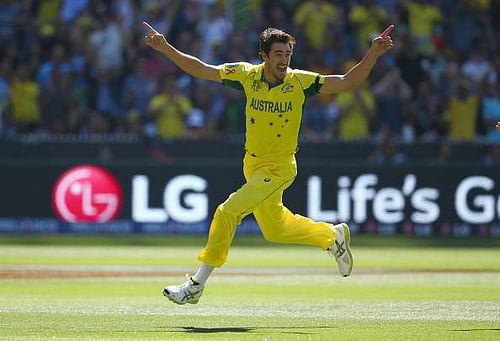
Under the SKanner: Mitchell Starc

2015 ODI World Cup Final, Melbourne
Australia vs New Zealand
Over 0.5
Mitchell Starc to Brendon McCullum
The New Zealand captain skipped out in confidence against Australia's main weapon, Mitchell Starc, only to see a quickish yorker elude his bat and crash into the poles. It is fair to say that the result of the final was decided in that very delivery.
The rise of Starc
Brendon McCullum had led the Kiwis from the front right through the tournament and like they say, he wasn't someone who would defend out an over even if it meant the best in the business was bowling. Fighting fire with fire was his way of leading and batting.
But in the finals, he ran into a young, lethal fast bowler, Mitchell Starc. The tall left-hand seamer emerged from the shadow of the other 'Mitch' in the Australian side, Mitchell Johnson. Such was Starc's influence right through the World Cup that Australia and its fans barely missed 'The Mo'.
Barring a few injuries, Mitchell Starc has spearheaded the Australian bowling attack in all forms of the game with conviction. He, of corse, has an able ally, the ever so reliable McGrath-like Josh Hazlewood. If Hazlewood has the line, length and consistency to trouble batsmen like Glenn McGrath, Mitchell Starc is every bit as good as the Brett Lee of the 2000s, if not better.
He isn't the conventional leader of a pace attack who relies on line, length and the odd bouncer to nip batsmen out. Starc is a wicket-taker and a ruthless one at that. He is at the batsmen be it at the start of an innings, the middle overs or the death.
Starc's career graph has only gone upward since that World Cup final. In ODIs, the left-hand seamer has taken 46 wickets in 24 games since the 2015 World Cup final. He is sixth in the list of bowlers with most wickets since the World Cup and the third highest in the fast bowlers list behind Kagiso Rabada and Trent Boult.
But what sets him apart is a mind boggling strike rate of 27.2 and an economy of 4.99. A combination of good strike rate and low economy is such a rarity in modern day cricket that there is little doubt regarding Starc's rising supremacy in World cricket. Here we take a glance at his strengths and weaknesses ahead of the Champions Trophy.
Strengths
#1 Taking wickets in the first over
Between 2015 and 2016, Mitchell Starc took 19 wickets in the first over of an innings across all formats, the most by any bowler by a long margin. The next best is seven. Of these 13 are right-handers who have had trouble with his late swing with the new ball.
In 27 ODIs during that period, he had taken 11 wickets in the first over. That is a scary statistic for opening batsmen set to face the menacing bowler in the Champions Trophy in England.
#2 Late swing and toe-crushing yorkers
Starc’s biggest weapon in ODIs – late swing with the new ball. When he swings the ball through the air, it begins angling in very very late making it pretty tough for batsmen to play the final line of the ball. Combine this with his ability to land a perfect yorker, and Starc is a nightmare in yellow.
What sets apart the left arm pacer is his confidence to pull off the yorker even with the new ball. The shine does not stop him from landing that yorker right on the money and this means batsmen are more often than not fumbling with two things at the same time - the late swing and the anticipation of a yorker.
#3 Ability to change the angle of attack
There is a simple, yet effective tactic for fast bowlers that is often ignored in modern day cricket. Changing the angle of attack to around the wicket. The great Wasim Akram used the around the wicket angle to wreath havoc in the 1992 World Cup final against England.
Like Akram, Starc is someone who has used his angle to fight the modern bats and 360° batting. He can generate reverse swing late in the innings and comes around the wicket to angle the ball into the right-handers before taking it away with reverse swing. This is a pretty effective tactic even against the best in the business like AB de Villiers.
#4 Pace
For someone as quick as Mitchell Starc is, pace is always a big weapon. There is the fact that quicker balls fly quicker to the fence but when combined with precision, quick bowlers are always a threat. Starc bowls above 140kmph most of the time and can get it up to the high 150s making him a huge threat at any time of the innings.
There are umpteen occasions in the past few years where he has outfoxed the batsmen with sheer pace. In fact, someone as good as Hashim Amla has struggled to deal with Starc due to his ability to clock 150+ even when bowling bouncers.
Also read: Champions Trophy Flashback: Emergence of Yuvraj Singh & Zaheer Khan
Weaknesses
#1 Constant tryst with injury
Mitchell Starc's biggest issue is his constant injury problems. As recently as the Indian tour, he suffered a foot injury ruling him out of the series and the subsequent Indian Premier League.
He is someone Australia have a specific workload management program for and rightly so given that he has had so many injuries since debuting. While a full strength Starc is a beast, it remains to be seen how match fit he is after the foot injury.
#2 Lack of variations at the death
One of the things about really quick fast bowlers is that they hesitate to slow it down even for a variation. Starc relishes his pace, quickish yorkers and bouncers that he barely bowls a slow ball or a cutter. The death overs see him employ the quickish yorker as the primary weapon.
This kind of makes him a predictable bowler in the death. Not that yorkers aren't effective, but modern batsmen are so adept at churning runs out of yorkers that it now mandatory that bowlers have a few other tricks up their sleeve in the death.
Also read: Sachin: A Billion Dreams - 5 unknown facts revealed in the movie

